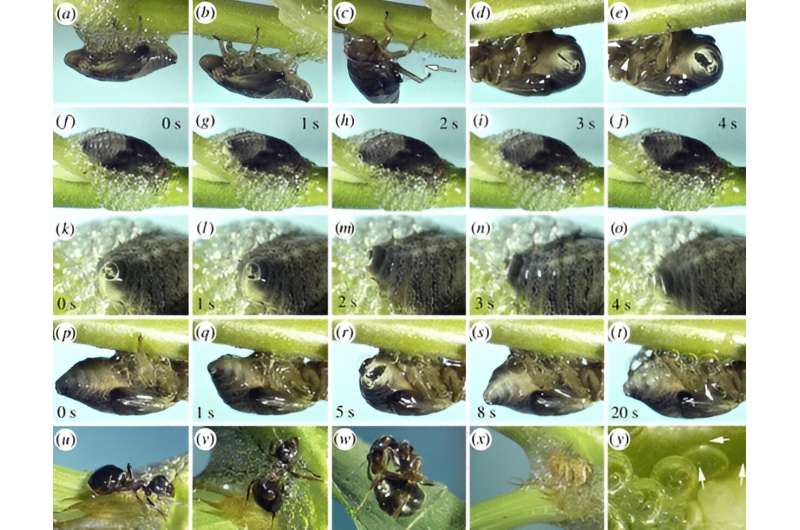January 12, 2024 report
This article has been reviewed according to Science X's editorial process and policies. Editors have highlighted the following attributes while ensuring the content's credibility:
fact-checked
peer-reviewed publication
trusted source
proofread
European alder spittlebug nymphs found to protect themselves with coat of bubbles

A small team of botanists, biologists and natural scientists affiliated with several institutions in Germany has found that European alder spittlebug nymphs protect themselves with a coat of bubbles they generate themselves. The paper is published in Journal of the Royal Society Interface.
Spittlebugs, known more commonly as froghoppers, are a type of insect that jumps from plant to plant to find nourishment. In this new effort, the research team focused on specimens in their nymph stage, when they are more vulnerable to predators.
To learn more about the bugs, the researchers went out into the field and collected several specimens. They also collected several ant and spider specimens, known to eat spittlebug nymphs, when the opportunity presents itself.
To protect itself, the spittlebug nymph emits a soap-bubble-like material from its anus, covering itself. The team found the coating protects the nymph in many ways. The first and most obvious is the barrier it represents.
Predators must push their way through the bubble coat to get at the nymph inside. Second, the bubble coat is sticky, which makes it difficult for predators to access the nymph—it also impedes the movement of predators due to its thickness and stickiness. And finally, the research team found that the bubbles also ward off bacteria, viruses and fungi.
In studying the means by which the bubbles are made, the research team found that the nymphs have developed a very efficient bubble factory. After consuming sap—their main source of food—the xylem makes its way through the digestive tract, and some of it is excreted while the rest is converted to the material used to make the foam. Both are ejected through the anus, but at different times.
When making bubbles, the syrupy material is mixed with air. The nymph then moves both its body and its nozzle-like anus to apply the bubbles to its body, completely covering itself.
The researchers also found that the bubble material evaporates as fast as water and becomes stickier, making it increasingly difficult for predators. They noted that ants that were thwarted in their attempts to get at a bubble-covered nymph took several minutes to clear the material from their bodies before leaving the scene.
More information: Hannelore Hoch et al, Adhesive properties of Aphrophoridae spittlebug foam, Journal of The Royal Society Interface (2024). DOI: 10.1098/rsif.2023.0521
Journal information: Journal of the Royal Society Interface
© 2024 Science X Network




















